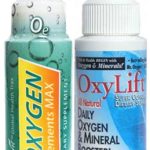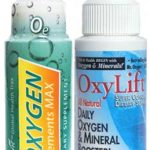Being that it’s the third most abundant element in the entire universe, it might not surprise you to learn that humble, old oxygen is the most abundant element in the human body (which makes even more sense when you factor in that, despite all the chemicals in the Earth’s atmosphere, 20 percent of it up there’s made of oxygen1). In actual fact, a whopping 65 percent of our body mass is accounted for by oxygen2 – and, yes, that really does have everything to do with the fact it’s everywhere and all around us, so we’re breathing it in each and every second of our lives. Again, little surprise then that this odourless, colourless gas3 is so critically important for basic and healthy function in the human body. But just why and how? And, despite its abundance, are all of us actually getting enough oxygen?
What are the benefits of oxygen?
Oxygen is primarily necessary to enable the crucial process that’s known as cellular respiration – the breaking down of food in the body to provide its cells with energy so the body itself can properly function4, 5. In this process, oxygen’s called on to break down sugar in order to transform it into adenosine triphosphate (ATP), ensuring then it’s in a form absorbable by cells6; resulting in the by-products that are water and carbon dioxide (the latter, which is toxic, is removed from the body via respiration, of course).
Quite clearly then, the body requires an ever-ready supply of oxygen to function at all effectively – without it, a plethora of health issues will inevitably arise8. And yet, one study has discovered that laboratory mice, thanks to receiving supplemental oxygen, enjoyed increased T-cell counts, immune function and twice the lifetime of mice allowed normal oxygen levels7. So, could all of us do with receiving more oxygen? Well, exactly how much each of us needs (everyone clearly needs a lot, but some more than others) depends on things like general health, how active you are and how hydrated you are8. If you’re not doing well in those areas – yes, you probably could do with more oxygen in your body.
What are if you don’t get enough oxygen?
Quite clearly, it’s bad for your health. We’re not talking oxygen deprivation here per se; more oxygen deficiency. You can experience the latter over many months and years, with pollution and questionable indoor air quality often serving as culprits, as well as the very gradual decline of oxygen in the atmosphere9. And, like it or not, some experts have linked oxygen deficiency to tumour growth10, 11.
Oxygen supplements
So, how does one actually boost their oxygen intake? By breathing more? Well, no. One genuinely effective way is through naturally-derived supplementation. For instance, at The Finchley Clinic we’re presently finding two of our highly reputed oxygen products (Oxygen Elements Max and OxyLift; which, yes, essentially provide similar benefits) very popular. So much so, we’ve decided to make them both available on special offer – together. Why? Because a number of our customers find that one works for them better than the other; but many definitely find one of them of great benefit for their overall health. So why not take a look at them both – and try them out for yourself…?
 Oxygen Elements Max – may help with the following issues: candida overgrowth, fatigue problems, joint issues (in conjunction with Silica Plus), poor immunity, respiratory problems and boosting athletic performance.
Oxygen Elements Max – may help with the following issues: candida overgrowth, fatigue problems, joint issues (in conjunction with Silica Plus), poor immunity, respiratory problems and boosting athletic performance.
 OxyLift – a synergistic blend of powerful nutritional supplements that provide oxygen, hydrogen, structured water, etheric respiration energies, major and trace minerals, enzymes and amino acids.
OxyLift – a synergistic blend of powerful nutritional supplements that provide oxygen, hydrogen, structured water, etheric respiration energies, major and trace minerals, enzymes and amino acids.
References:
- University of Florida. ‘Liquid Oxygen’. Environmental Health & Safety. University of Florida.
- Shyamala I. ‘Building Blocks of Life’. ASU – Ask A Biologist. Sep 2009.
- org. ‘Oxygen – Element Information, Properties and Uses | Periodic Table’. Royal Society of Chemistry.
- Alberts B., Johnson A., Lewis J. et al. ‘How Cells Obtain Energy from Food’. Molecular Biology of the Cell. 4th edition. New York: Garland Science; 2002.
- phy. ‘Cellular Respiration’. Hyperphysics.
- Encyclopædia Britannica. ‘Adenosine Triphosphate’. Encyclopædia Britannica Online. Encyclopædia Britannica Inc.; 2016.
- Hatfield S. M. et al. ‘Immunological mechanisms of the antitumor effects of supplemental oxygenation’. Science Translational Medicine. Vol. 7; Mar 2015; p. 277ra30. doi: 10.1126/scitranslmed.aaa1260.
- nih. ‘What Is Oxygen Therapy?’. National Heart, Lung, and Blood Institute; Feb 2012.
- Scripps Institution of Oceanography. ‘Scripps O2 Program | Atmospheric Oxygen Research’. Scripps Institution of Oceanography.
- ‘An Introduction to Indoor Air Quality’. United States Environmental Protection Agency.
- University of Colorado Denver. ‘Lack of oxygen in cancer cells leads to growth and metastasis’. ScienceDaily; Sep 2012.
